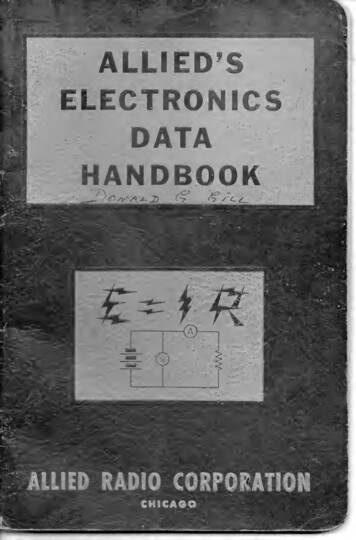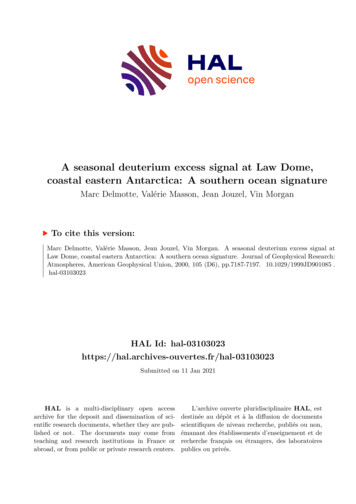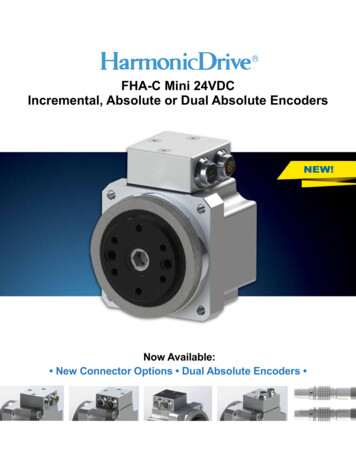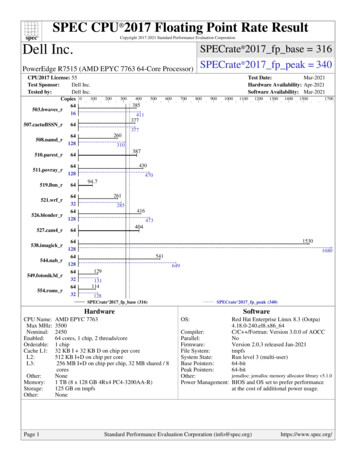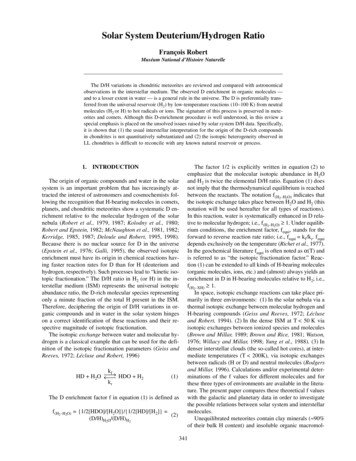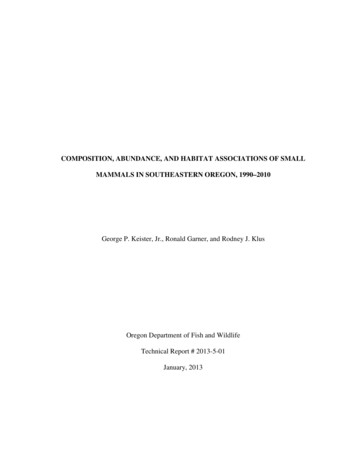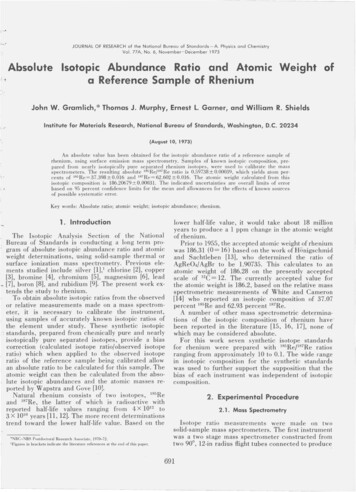
Transcription
--- - - - - - - - - - --I1- 'r/IJOURNAL OF RESEARCH of the Notional Bureau of Standards - A. Physics and ChemistryVol. 77A, No.6, November- December 1973Absolute Isotopic Abundance Ratio and Atomic Weight of'"a Reference Sample of RheniumJohn W. Gramlich,* Thomas J. Murphy, Ernest L. Garner, and William R. Shields,/Institute for Materials Research, National Bureau of Standards, Washington, D.C. 20234(August 10, 1973)J,An absolute value has been obtained for the isotopic abundance ratio of a reference sample ofrhenium, using surface emission mass spectrometry. Samples of known isotopic composition , prepared from nearly isotopically pure se parat ed rhenium isotopes , were used to calibrate the massspectrometers. The resulting absolute '85 Re/'·7 Re ratio is 0.59738 0.00039, which yields atom per·cents of ' 8s Re 37 .398 0.016 and '87Re 62.602 0.016. The atomi c weight calculated from thisisotopi c c omposition is 186.20679 0.00031. The indi cated uncertainties are overall limits of e rrorbased on 95 perce nt confidence limits for th e mean and allowances for the effe cts of known sourcesof possible systematic error.Key words : Absolute ratio; atomic weight; isotopic abundance; rhenium.1. IntroductionThe Isotopic Analysis Section of the NationalBureau of Standards is conducting a long term profgram of absolute isotopic abundance ratio and atomicweight determinations, using solid-sample thermal orsurface ionization mass spectrometry. Previous elements studied include silver [1],1 chlorine [2], copper[3], bromine [4], chromium [5], magnesium [6], lead, [7], boron [8], and rubidium [9]. The present work extends the study to rhenium.To obtain absolute isotopic ratios from the observedor relative measurements made on a mass spectrometer, it is necessary to calibrate the instrument,using samples of accurately known isotopic ratios ofthe element under study. These synthetic isotopic:. standards, prepared from chemically pure and nearlyisotopically pure separated isotopes, provide a biascorrection (calculated isotope rati%bserved isotope, ratio) which when applied to the observed isotoperatio of the reference sample being calibrated allowan absolute ratio to be calculated for this sample. Theatomic weight can then be calculated from the absolute isotopic abundances and the atomic masses reported by W apstra and Gove [10].Natural rhenium consists of two isotopes, 185Reand 187Re, the latter of which is radioactive withreported half-life values ranging from 4 X 10 12 to3 X 10 10 years [11,12]. The more recent determinationstrend toward the lower half-life value. Based on the*NRC- NBS Po stdoctoral Research As sociate. 197(}"72.1 Figures in brac kets indicate the lite rature references at th e end of thi s pape r.lower half-life value, it would take about 18 millionyears to produce a 1 ppm change in the atomic weightof rhenium.Prior to 1955, the accepted atomic weight of rheniumwas 186.31 (0 16) based on the work of Honigschmidand Sachtleben [13], who determined the ratio ofAgRe04/AgBr to be 1.90735. This calculates to anatomic weight of 186.28 on the presently acceptedscale of 12C 12. The currently accepted value forthe atomic weight is 186.2, based on the relative massspectrometric measurements of White and Cameron[14] who reported an isotopic composition of 37.07percent 185Re and 62.93 percent 187Re.A number of other mass spectrometric determina·tions of the isotopic composition of rhenium havebeen reported in the literature [15, 16, 17], none ofwhich may be considered absolute.For this work seven synthetic isotope standardsfor rhenium were prepared with 185Ref187Re ratiosranging from approximately 10 to 0.1. The wide rangein isotopic composition for the synthetic standardswas used to further support the supposition that thebias of each instrument was independent of isotopiccomposition.2. Experimental Procedure2.1. Mass SpectrometryIsotope ratio measurements were made on twosolid· sample mass spectrometers. The first instrumentwas a two stage mass spectrometer constructed fromtwo 90 , 12-in radius flight tubes connected to produc 691----,
Lan "5" configuration. The instrument was equippedwith an air operated beam valve [18] and a thin lens"Z" focussing source [19]. Ion detection at the end ofthe second stage was accomplished with a 17·stage ionmultiplier coupled to an amplifier, discriminator, andscaler [18]. The magnetic field of each stage was in dependently controlled by a controller-gauss meter.Each mass was brought into focus at the collector bycomputer switching of the magnetic fields Timingand data collection were also under computer control.The second instrument was a single stage 60 , 6-inradius of curvature mass spectrometer equipped witha "Z" -lens source identical to that used in the twostage instrument. The collector was a deep bucketFaraday cage type equipped with a 50 percent transmission grid shadowing a series of suppression grids[19]. The measuring circuit consisted of two vibratingreed electrometers operated as a master-slave combination, a voltage to frequency converter, and a scalertimer. As with the first instrument, data collectionwas by computer control.Prior to this study, it was established that the biasof the two stage instrument was independent of theisotopic ratio through the measurement of a series ofseventeen uranium isotopic standards covering arange of isotopic compositions from approximately235U/238U 0 005 to 187. That a single bias correctionis valid for the single stage instrument over the rangeof isotopic compositions measured has been established previously through the measurement of synthetic isotopic mixtures of boron [8], chromium [5],magnesium [6], and rubidium [9].Samples were mounted on a single tungsten filamentwhich had been previously degassed in a vacuum ata temperature of approximately 2000 C and under apotential field. No rhenium background was observed from degassed filame nts. About 10 pJ of samplesolution containing 5 mg/ml of rhenium as perrhenicacid in 5 percent sulfuric acid was placed on a tungstenfilament. A high purity platinum wire anode, whichwas cleaned with dilute nitric acid between each plating, was placed on the top of the solution drop andrhenium was electrolytically deposited onto thetungsten at a potential of 2.25 V and a current densityof 10 ma/cm 2. Approximately 1 h was required fordeposition. The filament was immersed in tripledistilled water, dried under a heat lamp and placed ina bell jar purged with extra-dry hydrogen. The sampleswere reduced in a hydrogen atmosphere by passing acurrent through the filament. For samples analyzedon the two stage instrument, the current was increasedslowly until white vapors were seen to emanate fromthe filament. After 5 s at this temperature the currentwas increased until the filament temperature was justbelow red heat. The current was turned off after 10 sat this temperature. The above plating and hydrogenreduction procedure was repeated with a second 10ILl drop of solution after which the filament was immediately placed into the mass spectrometer. Sampleswere analyzed on the two stage instrument at a filamenttemperature of 19000c.Samples analyzed on the single stage machine weretreated in a slightly different manner during the ' -,hydrogen reduction step. The filament was heateduntil fuming was observed. After fuming ceased, the , .c urrent was slowly increased until the sample deposit ""started to bubble and change from black to gray in '1color. The current was maintained at this setting for1 min and then increased until a faint red glow wasobserved in the filament. The current was then re- 1 Iduced to a point where the red glow was no longer Ivisible and allowed to remain at this temperature for 30 s. This plating and hydrogen reduction was re- Ipeated for a total of three times after which thefilament was placed into the mass spectrometer andanalyzed at a temperature of 2100Although the analysis procedure used by each ,operator was somewhat different, each operator Iperformed all of his analyses in an identical manner. '!Filament temperature, heating pattern, signal in- ;tensity, and time of data taking were controlled withinstrict limits. No filament fractionation was observedduring the analyses on the two stage instrument,however, at the higher filament temperature used onthe single stage mass spectrometer a small amountof fractionation (less than 0 1%) was observed during) :the analyses0c.2.2. Purification of the Separated IsotopesElectromagnetically separated 185Re and 187Re iso- topes , in the form of rhenium metal powder, wereobtained from the Isotopes Division, Oak Ridge National Laboratory of the Union Carbide Nuclear Com- ,Ipany. The 185Re was designated Series PF Sample '184501 and the 187Re was designated Series DDSample 135001. The Certificates of Analysis whichaccompanied each sample included a semiquantitativespectrographic analysis whic h showed that the principal impurities were sodium, potassium and calcium -,at greater than 0.1 percent. While these elementswould not interfere with the assay method for rhenium, several others which were reported at the 0.02to 0.05 percent concentration range could interfere.Among these elements were molybdenum, vanadium,tungsten, bismuth, mercury, tin, silver, lead, and ,platinum all of which interfere with the assay of c:;rhenium by tetraphenylarsonium chloride [20, 21] byforming insoluble compounds.To reduce these impurities to a level low enough sothat they could not cause a significant error in thedetermination of the rhenium ion in solutions of theseisotopes, the separated isotope samples were furtherpurified by a combination of chloride precipitation to remove insoluble chlorides, cation exchange to removecationic inpurities, anion exchange to remove anionicimpurities and electro-deposition to separate thepurified rhenium from the organic material dissolvedfrom the ion exchangers.Each separated isotope was treated as follows: Therhenium metal powder (about 0.5 g) was dissolved in50 ml of 4N nitric acid. The resulting solution wasevaporated to constant volume at about 50 C. (The692
-- - - - - -temperature was kept low so as to minimize the lossof rhenium through volatilization.) The residue wastaken up in a little water and 1 ml of 6N hydrochloric"-J acidwas added to precipitate insoluble chlorides.The solution was again evaporated to constant volumeat about 50 C, and the residue taken up in about 75ml H 20. The solution was filtered through fine textured filter paper and passed through a cation ex) \ change column containing about 20 ml of AG 50 X 8,100-200 mesh, strongly acidic cation exchange resinto remove cationic impurities. The column was washedwith 100 ml of water and the eluent was evaporatedto about 35 mI.The perrhenic acid solution was then passed throughan anion exchange column containing 35 ml of AG,/" 1 X 8 resin, 100- 200 mesh, strongly basic anion exchange resin. The anionic impurities were eluted bysuccessive elution with 50 ml H20 , 100 ml of a solutionIN in NH40H and IN in NH4CI, 75 ml H 20, 100 mlIN HN0 3 , and 50 ml H 2 0. Rhenium was then elutedwith 350 ml of ION HNO a. This solution was thenevaporated to cons tant volume of perrhenic acid withthe last few ml being evaporated at about 50 C tominimize the loss of rhenium. The residue was takenup in 200 ml of 5 percent (w/v) H 2 S0 4 , transferred toa 400 ml quartz beaker and diluted to 300 ml with 5percent (w/v) H 2 S0 4 Rhenium metal was e]ectrodeposited onto a platinumgauze cylindrical cathode (cylinder 5 cm X 1.2 cm) atan applied potential of 2.6V. The solution was stirredmagnetically using a Teflon 2 covered stirring bar.After overnight electrolysis, the cathode was washedwith water and the rhenium dissolved with 50 ml of8N HN0 3 The electrode position was repeated untilno rhenium deposited on overnight plating (fiveelectrodepositions). After each plating, the rheniumwas dissolved with the 50 ml of 8N HNOa. A smallamount of 30 percent H 20 2 was added to the electrolyte between electrolysis to dissolve the rheniumwhich deposted on the stirrer or beaker.The nitric acid solution containing the purifiedrhenium was evaporated to constant volume of perrhenic acid at low heat (50 C). The residue was thentaken up in a few ml of 6N HCl and again evaporatedto perrhenic acid at low heat. This addition andevaporation of Hel was repeated six times to insurethe removal of nitrate ion which interferes with theassay method for rhenium., 2.3. Preparation and Analysis of the Separated IsotopeSolutionsThe purified Hl85 Re04 and HI87Re04 were takenup in about 50 ml of H20, filtered, and transferred tospecial 200 ml borosilicate glass flasks. These ffaskswere constructed from volumetric flasks by cutting theneck of each flask about 1 cm from the body and tooling2 A commercial material is identified in this paper in order to adequately specify experimental procedure. Such identification does not impl y recommendation or endorse me nt bythe N alional Bureau of Standards.the neck for a No. 0 polyethylene stopper. The solutionswere diluted to about 140 ml and 0.5 ml of 30 percentH 2 0 2 was added to each. After loosly closing the flaskwith polyethylene stoppers, the solutions were heatedovernight at low heat to insure the complete oxidationof any reduced rhenium to the perrhenate state. Theexcess hydrogen peroxide was then removed by addinga small piece of platinum foil to each solution andheating the loosly stoppered flask overnight.A preliminary assay of the rhenium content of eachseparated isotope solution was effected by add ing2 ml of 2N NaCl and 2 ml of 2 percent tetraphenylarsonium chloride solution to a 15 ml, fine porosity,borosilicate glass filtering crucible. A weighed 1 mlportion of the rhenium solution was added and mixedby swirling to precipitate tetraphenylarsonium per·rhenate. After standing two hours, the solution wasremoved from the crucible by vacuum suction and theprecipitate was washed three times with small amountsof water. The approximate rhenium content of thesolution was calculated from the weight of the precipi·tate and the weight of the solution. The volume of thesolution was then adjusted so the concentration wouldbe close to 18 p. mol ReI g.Previous tests with known rhenium solutions showedthat this method is accurate to about 1 percent of therhenium present.The solution of HI85Re04 was designated "Re 185"and the solution of Hl87Re04 was designated "Re 187".(a) Nitrate Analysis - Since nitrate ion forms aninsoluble compound with the tetraphenylarsoniumion , (C6H5) S , used to assay the rhenium, bothsolutions were analyzed for nitrate. The "Re 185"solution was analyzed for nitrate ion before the addition of hydrogen peroxide by the brucine sulfate test[22] and was found to contain less than 0.0001 percentNOil. The "Re 187" solution was analyzed for nitrateafter the addition of hydrogen peroxide. It was necessary to make the sample alkaline and evaporate todryness to destroy the last trace of H 2 0 2 beforedetermining nitrate by brucine test. This solution wasalso found to contain less than 0.0001 percent NOi(b) Impurity Analysis-Samples of the "Re 185"and "Re 187" solutions were analyzed for impurityelements by isotope-dilution spark source mass spectrometry [23] Samples equivalent to about 5 mg ofRe were spiked with 1O- 7g of l09Ag, l37Ba, 44Ca, 111Cd,53Cr 65CU 54Fe 113In 41 K 26Mg 97Mo 62Ni 206Pb195p;, 82S e : JJ7S , 86S;, 125Te, 203Tt, 183W, and 672n.'The solutions were evaporated to small drops, evaporated onto gold wires and analyzed by spark sourcemass spectrometry. In addition to these elements Biand Mn which are mononuclidic elements were estimated by comparing to other nuclides. Table 1 showsthe results of these analyses as well as the results ofthe analysis of a doped natural rhenium sample whichwas purified in the same manner as the separatedisotope. This sample had been doped with 0.1 percentof Ag, Bi, Cr, Mn, Mo, Pb, Sn, and V to determine theefficiency of the purification in removing elementswhich could interfere with the assay of the rheniumsolutions.693
TABLEElement1. Analysis of purified rheniumNaturalRe(ppm)AgBaBi bCaCdCrCuFe0.30.5a 0.232a 125K62a 0.5a 0.74a 1.7MgMn cMoNiPbPtSeSnSrTeycWZnaII 3a O.S0.20.3a",; 0.5""53"Re lS5" "Re lS7"(ppm)(ppm)120.25.S51.55.710IS1.60.5",;944.3160 52.70.51",; 0.5",;31710.50.2540.4125.1161.20.5212.314 310.21",; 0.523a Concentration before purification -1000ppm.b Compared to 2()6Pb.c Compared to 53Cr and 54 Fe.The only element that was detected at a concentration level high enough to interfere with the assayof rhenium was platinum at 160 ppm in the "Re 185"solution. This apparently came from the platinumcathode used for the rhenium purification. To determine how much of this platinum precipitated withthe tetraphenylarsonium perrhenate in the assay ofthe "Re 185" solution, the material was analyzed forplatinum by isotope dilution - spark source massspectrometry. After the assay, one of the precipitatedsamples was dissolved in acetone and an amountequivalent to 5 mg of Re was spiked with 10- 7 g 195Pt.Enough water was added to make the solution about50 percent in H20 and the solution was passed througha cation exchange column (6.5 cm X 1.2 cm filled to3.5 cm with AG 50 X 8, 100-200 mesh cation exchangeresin) and washed with about 20 ml of water to freethe solution of tetraphenylarsonium ion. The eluatewas evaporated and analyzed by spark source massspectrometry as the previous samples. The platinumwas found to be 20 ppm in the precipitate and a smallcorrection (35 ppm) based on the Pt being present as[(C6H5)4As]2PtCIs has been applied to the weights ofprecipitate in the assay of the "Re 185" solution.2.4. Assay of Separated Isotope SolutionsFour weighed portions of about 15 g were withdrawnfrom each separated isotope solution in the followingmanner. A 4-in platinum needle was inserted through aNo. 0 polyethylene stopper and used to replace thestopper in the flask. A 20 ml polyethylene hypodermicsyringe was attached to the Kel-F hub of the needleand the desired amount of solution was withdrawn.The syringe was then disconnected from the hub and ;the tip was capped with a Kel-F cap. Any static chargethat might be present on the plastic syringe was dis- '-'sipated by wiping it with a da p lintless tow l. .The '"1syringe and contents were weIghed on a semimicrobalance to 0.02 mg. The solution was then deliveredfrom the syringe into a 100 ml Teflon-FEP beaker andthe syringe was again capped, wiped and weighed. ,The weight of the sample was determined from theweights of the syringe before and after delivery of thesample. Two samples were withdrawn from each solution before the calibration samples were withdrawn andtwo samples were withdrawn after the calibration samples to insure that no change in concentration occurredduring this time interval (about 6 h).Each weighed portion was then assayed as follows:A tetraphenylarsonium chloride reagent solution wasprepared by diluting 150 ml of a 2 percent (w/v) solutionof tetraphenylarsonium chloride hydrochloride [(C6H5)4AsCI' HCl . H20] to 650 ml with subboiling distilledacetone (the 2% tetraphenylarsonium chloride solutionwas filtered twice through close textured filter paper ·before use). Sixty-five ml of this reagent solution wasadded to the weighed portion of the separated isotope' ,solution. The solution was mixed with a Teflon rodand the rod was removed and washed with acetone.The acetone was allowed to evaporate from the uncov- iered beaker in a Class-lOO clean air hood and theevaporation continued until all of the acetone evap- rorated and about 20- 25 ml of solution remained in thebeaker (about 20 h). (Tetraphenylarsonium perrhenateis soluble in the initial acetone-water mixture and slowlycyrstallizes from the solution as the acetone evaporatesproducing relatively large crystals when compared tothe usual method of precipitation.)The crystalized tetraphenylarsonium perrhenate,(CsH5)4AsRe04, was transferred with 0.1 percenttetraphenylarsonium chloride solution to a tared 15 ml "fine porosity borosilicate glass filtering crucible. Sinceit was not possible to completely transfer the salt,the material remaining in the beaker was dissolvedwith acetone and the acetone evaporated at 50 C. Asmuch of the salt as possible was washed into the filtering crucible using the dilute reagent solution. Thisdissolution in acetone, evaporation, and transfer pro- ticedure was repeated twice more so that the amount ofmaterial remaining in the beaker was small. Thematerial in the crucible was washed three times with Iwater and the crucible and contents were dried at125 C for 3 h. (The filtrate and original beaker werereserved for the determination of dissolved and untransferred rhenium.)The filtering crucible and contents were cooled ina desiccator, transferred to the case of a microbalance and allowed to stand for several hours. Thecrucible and contents were then weighed to O.002 mg.A buoyancy correction for the glass crucible was madeby averaging three empty tare crucibles. The air weightof the (C6H5)4AsRe04 was then determined and con- "verted to vacuum wejght using a measured value of1.93 as the density of the salt at 23 C. The micromoles694
(/Lmol) of rhenium present in the salt was determinedusing a calculated atomic weight for rhenium and 1971I atomic weight values for the other elements. The -J formula weights usedwere 632.3032 for (C 6 H 5 )4Asr 185Re04 and 634.2834 for (C 6 H4)4As 187Re04.The filtrate from the 'precipitation of the tetraphenyl·arsonium perrhenate was transferred to the originalbeaker and about 50 ml of acetone was added to insurethat any untransferred salt dissolved. The "Re 185"A. solutions were spiked with about 1.1/Lmol of 18 7Re andr the "Re 187" solutions were spiked with 1.1 /Lmol of185Re for determining soluble and untransferred rhen·ium by isotope dilution mass spectrometry.The spiked solution was mixed, evaporated to dry·ness, and the residue was taken up with 10 ml of a solu·tion that was 50 percent 2N HCl and 50 percent acetoneby volume. This solution was passed through an anion exchange column (6.5 X 1.2 cm filled to 3.5 cm with AG1 X 8, 100-200 mesh anion exchange resin) washedwith a few ml of the acetone - 2N H Cl mixture followedby 25 ml of IN HCl. The rhenium was eluted from thecolumn with 30 ml of 8N HN0 3 and the eluate was\. evaporated to dryness on a hot plate at low heat. Theresidue was taken up with 15 ml of 5 percent H 2 S04I ' andthe rhenium was electrode posited as rheniummetal onto a platinum wire cathode by electrolysis at2.4V applied potential for 16 h from a stirred solution.The rhenium metal was then stripped from the platinumwire cathode with 2- 3 ml of 8N HN0 3 and the res ulting, solution evaporated to dryness at low heat. This residuewas taken up with about 0.05 ml of 5 percent sulfuricr acid and the 185/187 ratio was determined by surfaceemission mass spectrometry. The rhenium found as/Lmol Re was added to the rhenium from the gravimetricdetermination to yield the total rhenium in the sample.Table 2 shows the results of these analyses.This method of determining the concentration ofrhenium solutions was previously tested on solutionscontaining known amounts of rhenium. Six solutionswere prepared from high· purity zone·refined rheniumin the approximate concentration of the separatedisotope solutions, 16.8 to 20.2 /Lmol Re/g. This highpurity rhenium was found to contain about 15 ppm ofFe and Al by spark source - isotope dilution analysis.Several other elements were detected at less than 5ppm so that the detected impurities totaled about60 ppm. Four samples containing from 250 to 290/Lmol of rhenium were withdrawn from each solutionand the rhenium concentrations were determined asdescribed above. Comparison of the calculated andmeasured concentrations detected a positive bias ofabout 0.03 percent but this would have a negligibleeffect on ratios.Pooling the results of the separated isotope solutionsas shown in table 2 with the results of the six setsdescribed above yields a value of 0.0018 /Lmol/g forthe standard deviation of an individual measurement(24 degrees of freedom). The standard error for theaverage of four determinations is therefore 0.0009/Lmol/g and the uncertainty of the concentration is0.0018 /Lmol/ g at the 95 percent confidence level.This corresponds to an uncertainty of 0.010 percentfor solutions containing 18 /Lmol Re/g.I.''-CTABLE 2.2.5. Isotopic Analyses ofthe Separated Isotope SolutionsEach of the separated isotope solutions were ana·lyzed four times on each of the instruments. Sourceswere cleaned between the analyses of the two solu·tions as a precaution against the possibility of cross·contamination from the source parts, however testsshowed that the two separated isotopes could beanalyzed back·to·back on the same source with nodetectable cross·contamination. Because of the poorprecision obtained from measuring large ratios onvery small signals on the single stage instrument,those analyses have not been included in the averageisotopic compositions reported in table 3, even thoughthe isotopic compositions obtained on the singlestage machine fall within the stated error limits. Inaddition, seven analyses on each separated isotopeobtained on the two stage instrument prior to thisstudy are indistiTlguishable from the values reportedin table 3. The isotopic compositions of the separatedisotopes given in table 3 have been corrected for massConcentration of rhenium isotope solutionsRheniumSolution"Re 185" {"Re 187" {SampleNo.Weightsolution 5.5707215.3173915.30674From ppt From mj.tmoiCone.solutionj.tmol 79617.9790Average 541277.856279.552275.031274.818Average .69517.9547
spectrometric bias, with changes becoming negligibleafter three rounds of iteration.TABLE3.Isotopic composition of separated rhenium isotopesused in calibration samplesIsotopic composition(atom percent)Separated isotope"Re 185"a99.5516 0.00220.4484 0.0022"The uncertainties are based on a minimum error of 0.5 percentfor the ratio determinations. The calculated 95 percent confidencelimits are well below this value.,'"Two complete sets of analyses of the calibration .,,\mixes and the standard sample were made, one byOperator # 1 using the two stage instrument and oneby Operator #2 using the single stage instrument.Each set consisted of 22 analyses of the standardsample made in a simple alternating pattern with three ""analyses each of the seven calibration mixes .2.6. Preparation of Calibration Samples3. Results and DiscussionSeven calibration samples were prepared by mixingweighed portions of the "Re 185" and "Re 187"solutions to produce 185Re/ 187 Re ratios ranging to 10 : 1to 1: 10 with two of them bracketing the observednatural ratio of 0.60 within a few percent. The portionswere withdrawn from the flasks and weighed in themanner previously described for the assay of the solutions. To eliminate any possibility of change in concentration of a isotope solution with time, the portionsfor the calibration samples were withdrawn from theflasks between the samples taken for assay over aperiod of about 6 h.Table 4 shows the composition of these calibrationsamples. The isotopic ratio of each calibration samplewas calculated from the isotopic analysis of the separated isotopes and the fLmol of rhenium from eachseparated isotope solution as determined from theassay and weight of solution taken.Each calibration sample was thoroughly mixed andevaporated to dryness at low heat ( 50 C) on a hotTABLE 4.J'-'2.7. Isotopic Analyses of the Calibration Mixes and theStandard Sample0.6769 0.003499.3231 0.0034"Re 187"plate. Each sample was evaporated separately to avoidany possibility of cross·contamination due to thevolatility of perrhenic acid. The calibration sam pIeswere then taken up in 5 percent sulfuric acid (w/v)so that 1 ml of solution contained 5 mg of rhenium.The results for the seven calibration mixes are sum·marized in table 5. For each operator, there are no ' 1,statistically significant differences between any of the Ivalues of the correction factor. Table 6 includes the Iobserved and corrected experimental 185Ref187Re Ivalues for the standard sample as well as the finalabsolute value for the isotopic ratio, with its associateduncertainty components.The calculation of the atomic weight of the reference "sample of rhenium is summarized in table 7.A limiting factor in the accuracy of an atomic weightfor naturally occurring rhenium is the variability in thenatural isotopic composition. Although a completesurvey of the consistency of this element's isotopiccomposition in nature has not been undertaken, morethan 10 years of measurements in this laboratory onrhenium filaments have shown no major variation inthe 185Ref187Re ratio among various lots of rheniumfrom different manufacturers.Composition of rhenium calibration samplesSampleNo.IsotopesolutionWeightsolution gIsoReIS1Re!L mol!L mol1"Re 185""Re 187"10.227371.05092183.053310.127720.8245818. 741239.3623022"Re 185""Re 9908913"Re 185""Re 5119994"Re 185""Re 5940565" Re 185""Re 6282576"Re 185"" Re 0.1078327"Re 185""Re 029355696Isotope ratio18 Re/ IS1 Re1I
-lTABLE 5.Calibrationsample No.! ;LDetermination. of mass spectrometer biasIsotopic ratio 185Re/ 187 ReCorrection factorCalculatedOperator IOperator II
minimize the loss of rhenium. The residue was taken up in 200 ml of 5 percent (w/v) H2S04 , transferred to a 400 ml quartz beaker and diluted to 300 ml with 5 percent (w/v) H2S04 Rhenium metal was e]ectrodeposited onto a platinum gauze cylindrical cathode (cylinder 5 cm X 1.2 cm) at an applied potential of 2.6V. The solution was stirred
